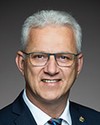It's a great question. Sure, I'm happy to answer that. I think it is an important question. What BioCanRx is concerned about is that our IP will go outside the country and be developed elsewhere.
Right now if an academic scientist should develop an invention, it belongs to that scientist and his research institute. They have to support the patents and they can try to find a way to develop them, but of course if they don't have any resources to do that, the scientist is often obligated to go outside the country to try to find a way to protect that intellectual property and develop it elsewhere. Therefore, what we're trying to do is to say is this: We're already investing in Canada in many ways. We're making great science, we're making lots of infrastructure and great clinical care. Let's just bring it all together and make sure that our IP is actually cultivated, maintained and actually established and produced in Canada as opposed to giving it away.
We all know the story of insulin. Insulin was developed in Canada many years ago and it's never been manufactured here. So to Allen's point, I think we need to start investing in our own biomanufacturing and our own science that we're already paying for to make things happen here.




